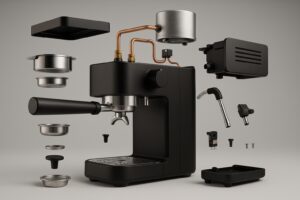Imagine you’re an artist with a blank canvas, a palette of vibrant colors at your disposal, and a vision in your mind. Now, picture this artist as a product designer, the canvas as the limitless possibilities of modern design, and the palette as the powerful tool of AI and design. This is the transformative journey we are embarking on in the realm of product design today. At the heart of this revolution is AI product design, a blend of creativity and technology that is reshaping how we develop and visualize products.
In my experience as a 3D product designer, the advent of AI has been nothing short of a revelation. It’s like having an incredibly skilled co-artist who not only understands your creative vision but enhances it, bringing ideas to life with unprecedented speed and precision. This article will delve into how AI is revolutionizing product design, focusing on the key aspects that make this technology a game-changer. From accelerating the design process to enhancing creativity, AI is proving to be an invaluable ally in the journey of product development.
Key Takeaways
- AI enhances creativity and innovation in product design.
- AI tools significantly reduce the time needed for design iterations.
- AI-generated designs offer high detail and realism, improving visualization.
- Human expertise is essential to refine and implement AI-generated concepts.
- AI in product design leads to better alignment with market trends and consumer needs.
AI in Product Design

AI in product design is more than just a technological upgrade; it’s a paradigm shift. At its core, AI leverages Machine learning algorithms to analyze data, recognize patterns, and generate design concepts that might take human designers hours, if not days, to develop. Tools like Mid journey and other Ai product design software are becoming essential in the toolkit of modern designers.
Let me share a personal anecdote that illustrates this shift. Not long ago, I was tasked with designing a new line of ergonomic office chairs. Traditionally, this would involve extensive market research, numerous sketches, and endless iterations. However, with AI, I could input the design parameters, such as ergonomic standards, material preferences, and aesthetic elements, into the software. Within minutes, I had a range of preliminary designs that met all the criteria. This not only saved a significant amount of time but also allowed me to explore creative options I might not have considered on my own.
AI doesn’t just accelerate the design process; it also enhances the creative potential of designers. By automating the routine aspects of design, AI frees up more time for designers to focus on the creative and innovative elements of their work. For instance, in the same project, I used AI to simulate different material textures and colors, creating a variety of looks for the chairs. This ability to quickly visualize changes and see the impact on the overall design is a powerful advantage that AI brings to the table.
In essence, AI product design is like having a versatile co-designer who can handle the heavy lifting, leaving you free to channel your creativity and expertise into crafting truly remarkable products. As we move forward in this article, we will explore more about how AI and human collaboration are reshaping the 3d product design landscape, making it more efficient, innovative, and aligned with market needs.
The Role of AI in Enhancing Creativity

When we think of creativity, we often imagine a solitary genius crafting a masterpiece in isolation. However, in the realm of product design, creativity thrives on collaboration and the exchange of ideas. Artificial intelligence design plays a pivotal role in this collaborative process, acting as a catalyst that sparks innovation and expands the horizons of what is possible.
AI tools like MidJourney are particularly adept at generating a wide range of design concepts from simple prompts. This capability is invaluable for exploring different creative directions quickly. For example, in another project I worked on, we were designing a new line of consumer electronics. Using AI, we were able to generate multiple design variations in minutes, each with unique features and aesthetics. This rapid iteration process allowed us to identify the most promising designs early on and refine them further.
One of the most exciting aspects of AI in product design is its ability to merge different artistic styles and influences seamlessly. Imagine blending the minimalist elegance of Scandinavian design with the intricate details of traditional Japanese craftsmanship. AI can do this effortlessly, offering designers a treasure trove of creative possibilities. This fusion of styles not only leads to innovative products but also appeals to a broader audience by incorporating diverse design elements.
However, the true power of AI lies in its ability to complement human creativity. While AI can generate countless design ideas, human designers bring a depth of understanding and intuition that is crucial for creating products that resonate with users. It’s the nuanced insights into user behavior, cultural trends, and emotional appeal that humans excel at, and these are essential for refining AI-generated concepts into market-ready products.
In practice, this synergy between AI and human creativity has led to some remarkable outcomes. For instance, in the design of a child’s nightlight, we used AI to generate various whimsical and playful designs. The AI produced numerous options, from animals to abstract shapes, each rendered with stunning detail and creativity. We then selected the most promising designs and refined them, ensuring they were not only visually appealing but also safe, functional, and aligned with the brand’s identity.
Accelerating the Design Process with AI
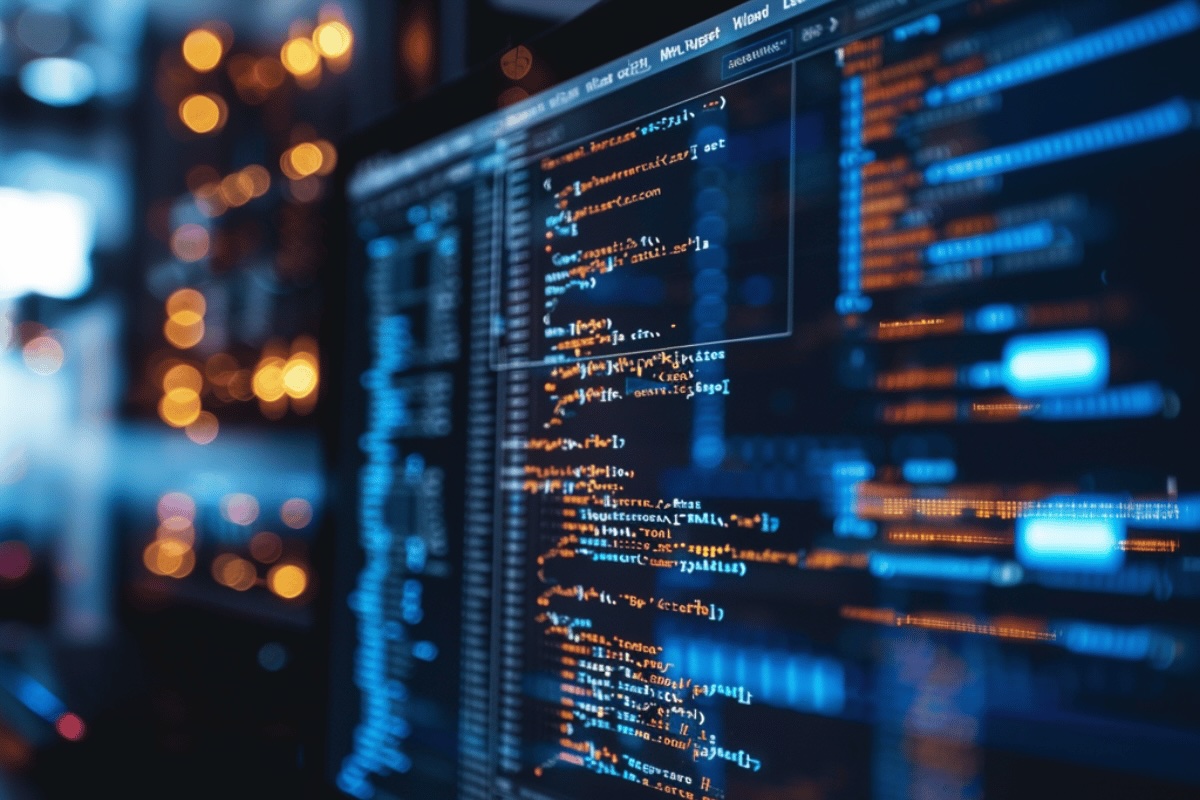
Speed is a critical factor in product design. The faster a design can move from concept to prototype, the sooner it can be tested, refined, and brought to market. AI excels in this aspect by drastically reducing the time required for design iterations. Traditionally, creating a detailed 3D model could take days or even weeks, depending on the complexity of the design. With AI, this process can be completed in a fraction of the time.
Consider the design process of a new smartwatch. The traditional approach would involve sketching, modeling, and prototyping, each step requiring significant time and effort. By integrating AI, designers can input their initial ideas and parameters into the software and receive multiple detailed 3D models within hours. These models can then be evaluated and adjusted quickly, allowing for rapid iteration and improvement.
This acceleration of the design process is not just about saving time; it’s about enhancing the overall quality of the product. Faster iterations mean more opportunities to test and refine the design, leading to a more polished and user-friendly final product. Moreover, the ability to quickly visualize different design options helps in making informed decisions early in the development process, reducing the risk of costly changes later on.
AI and Human Collaboration In Product Design
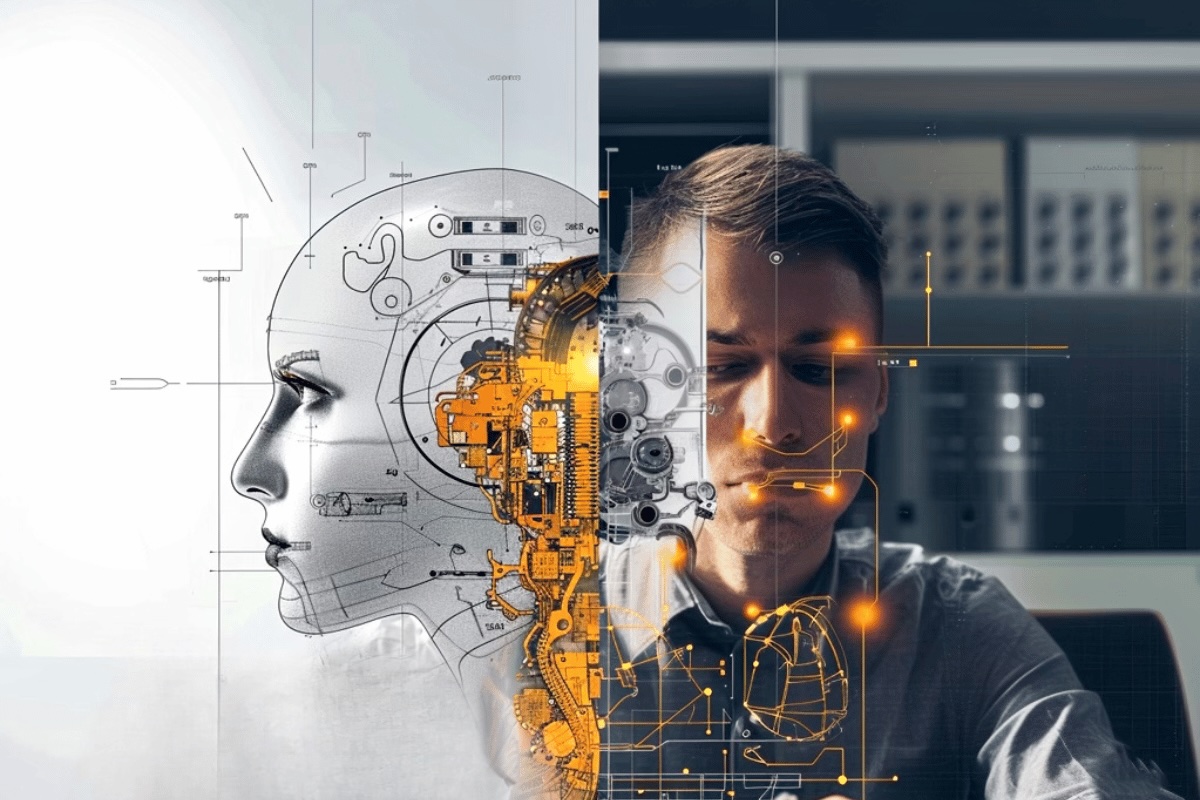
While AI brings remarkable efficiencies and creative possibilities to product design, the human touch remains indispensable. AI tools can generate a plethora of design options, but it’s the designer’s expertise that refines these options into practical, market-ready products.
Imagine the creation of a new ergonomic office chair. An AI tool like MidJourney can provide a variety of design concepts based on initial inputs. However, the designer’s role is to evaluate these concepts, considering factors such as material durability, comfort, and manufacturability. The designer’s insights and adjustments transform AI-generated ideas into a functional, aesthetically pleasing product that meets user needs.
This collaboration between AI and human designers enhances the overall design process. Designers can focus more on strategic and creative aspects, leaving repetitive and time-consuming tasks to AI. This synergy allows for a more efficient workflow and results in innovative products that are both creatively inspired and practically feasible.
Practical Applications of AI in Various Design Industries

AI’s versatility extends across numerous industries, each benefiting uniquely from its capabilities. Let’s explore how AI is revolutionizing fields such as architecture, fashion, product packaging, industrial design, product design, and automotive design.
Architecture and Interior Design
In architecture and interior design, AI tools like MidJourney enable designers to quickly generate conceptual images of spaces and structures. While these AI-generated images can look impressive at first glance, they are often tricky to control and may lack accuracy. This makes them useful for testing ideas but not for final designs.
Ai for architects allows professionals to visualize architectural projects, interior layouts, and decor elements with stunning realism. However, after using AI to create initial concepts, designers or rendering companies must further develop and refine these ideas. For example, we had a client who generated several images with AI that he liked, but he couldn’t achieve the precision he needed. As a result, he hired us to develop the chosen concept accurately.
This process helps clients see a more refined version of the final space before construction or renovation begins, making the design process more efficient and collaborative. Additionally, AI can optimize building designs for energy efficiency and sustainability, contributing to greener and more innovative architectural solutions.
Fashion and Apparel
The fashion industry benefits from AI’s ability to quickly conceptualize new clothing designs. Designers use AI to visualize new patterns, fabrics, and entire clothing lines, making the process from ideation to digital prototype faster and more efficient. AI can analyze fashion trends and consumer preferences, providing valuable insights that help designers create collections that resonate with their target audience. This results in fashion that is both trendy and commercially successful.
Product Packaging Design
In product packaging design, AI tools help designers visualize innovative packaging concepts quickly. AI can experiment with shapes, materials, and graphics in a virtual environment, allowing for rapid iteration and refinement. This leads to more creative and functional packaging designs that stand out on the shelves and meet consumer demands for sustainability and convenience. AI can also optimize packaging for cost-effectiveness and ease of production, ensuring that great design does not come at a high cost.
Industrial Design
In industrial design, AI tools like MidJourney enable designers to rapidly generate and iterate on complex components and machinery. AI can optimize designs for functionality and manufacturability, reducing the time and cost associated with traditional prototyping. For example, AI can simulate different materials and stress conditions, helping engineers select the best materials and structures for durability and performance. This leads to more efficient and innovative product designs, whether for machinery, consumer electronics, or other industrial applications.
Product Design
AI in product design is also transforming the broader field of product design. Tools like MidJourney and other AI-driven software allow designers to create highly detailed and realistic visualizations of new products. This speeds up the design process, enabling quicker iterations and more refined final products. AI can analyze market trends and consumer preferences, providing insights that help designers create products that better meet user needs and expectations. This results in products that are not only aesthetically pleasing but also highly functional and market-ready.
Automotive Design
In the automotive industry, AI plays a crucial role in both the design and engineering of vehicles. AI-driven tools can generate detailed renderings of car interiors and exteriors, allowing designers to explore various styles and features quickly. For instance, AI can help designers visualize different dashboard layouts, seating configurations, and exterior shapes, facilitating a more iterative and creative design process. Additionally, AI can assist in optimizing aerodynamics, fuel efficiency, and safety features, ensuring that new vehicle designs are both innovative and practical.
Challenges and Limitations of AI in Product Design
While AI presents numerous opportunities in product design, it’s essential to recognize and address its challenges and limitations. Understanding these can help designers and businesses effectively integrate AI into their workflows.
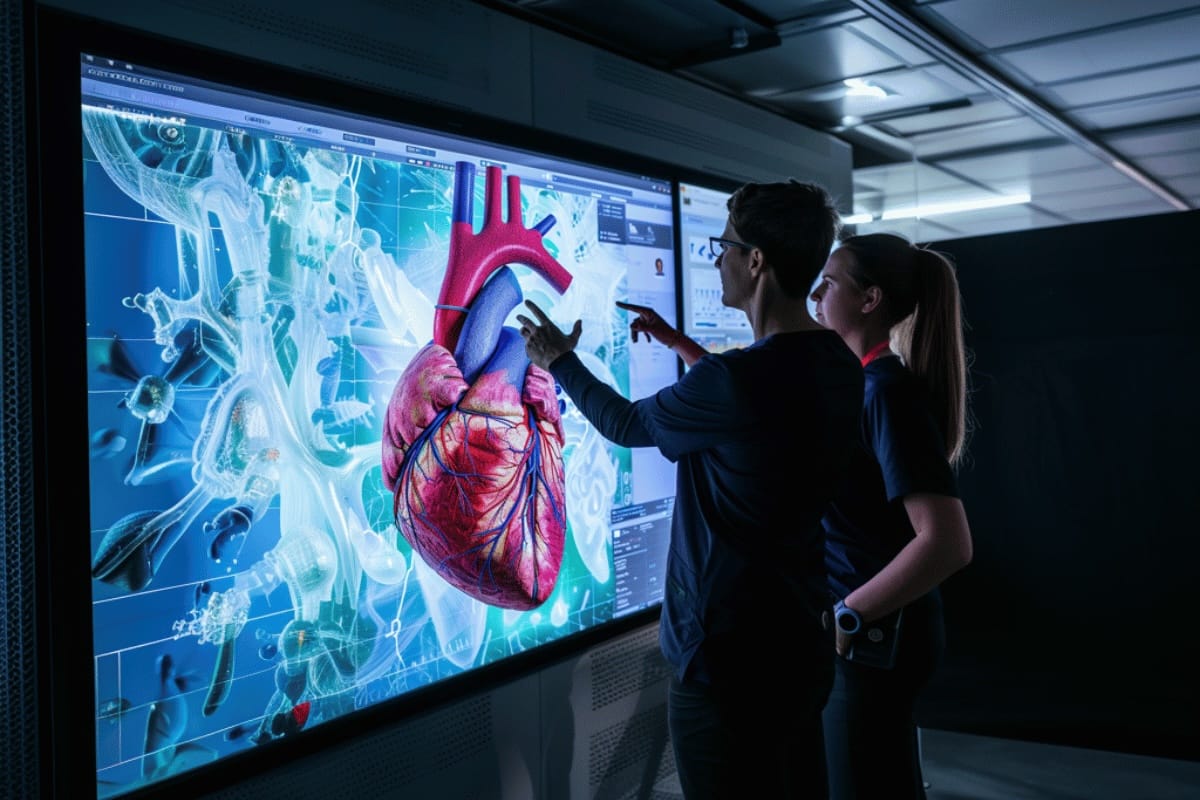
Elevate Presentations
Recognizing AI’s Limitations and Challenges
AI tools excel in generating creative concepts and detailed visualizations, but they have their constraints. Here are some of the main challenges:
Issues with Manufacturability and Practical Implementation
AI can produce stunning designs, but these designs may not always be feasible to manufacture. For instance, an AI-generated design might use materials that are too expensive or difficult to source. The structural integrity of a design may also be compromised if the AI does not fully account for engineering principles. Human designers must evaluate AI-generated concepts to ensure they can be produced efficiently and economically.
Data Dependency and Bias
AI algorithms rely heavily on the data they are trained on. If this data is biased or limited, the AI’s outputs may reflect these shortcomings. For example, an AI trained on a dataset of predominantly Western designs may not be able to create products that appeal to a global audience. Ensuring diverse and comprehensive training data is crucial to overcoming this challenge.
Technical Expertise and Integration
Integrating AI tools into existing workflows requires a certain level of technical expertise. Designers and engineers need to understand how to use these tools effectively and how to interpret their outputs. This often involves a learning curve and ongoing training. Additionally, integrating AI into existing systems and processes can be complex and may require significant adjustments.
Managing Client Expectations
With the impressive visualizations produced by AI, clients may have heightened expectations regarding the speed and readiness of the final product. Designers must manage these expectations by clearly communicating the stages of development that follow AI conceptualization. Emphasizing the importance of detailed engineering, prototyping, and testing is essential to ensure clients understand the complete process.
Human Expertise is Irreplaceable
AI can augment but not replace human creativity and expertise. The best results come from a collaborative approach where AI generates ideas, and human designers refine and implement them. Designers’ ability to think abstractly, empathize with users, and draw from a rich tapestry of experiences and knowledge is irreplaceable.
AI in 3D Rendering and Visualization
The integration of AI into 3D rendering and visualization has revolutionized the Product design process. These advancements have significantly improved the way designers conceptualize and present their ideas, making the entire process more efficient and visually appealing.
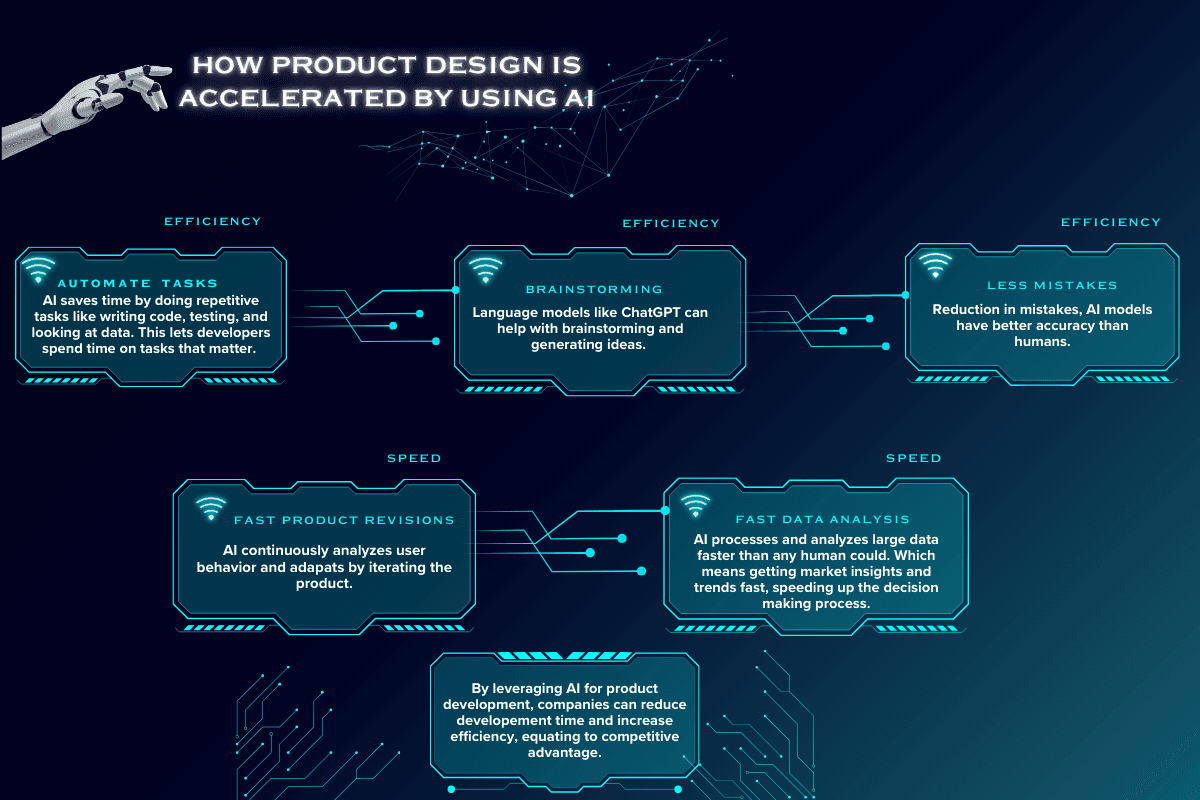
Enhancing 3D Rendering with AI Tools Like MidJourney
AI tools such as MidJourney have brought a new level of detail and realism to 3D rendering, helping designers quickly test ideas and enhance their renderings. While these tools can generate impressive photorealistic renders, they are not always accurate for final images. The true value of AI in this context lies in its ability to rapidly produce conceptual visuals, enabling designers to experiment with different ideas and iterate quickly. After using AI to explore initial concepts, designers or rendering companies still need to refine and develop these ideas to ensure precision and accuracy in the final renderings.
A Detailed Look at How AI Enhances 3D Rendering
AI in 3D rendering allows for the creation of intricate details that would be time-consuming and difficult to achieve manually. Textures, lighting, and shading can be rendered with a high degree of accuracy, providing a realistic representation of the final product. This level of detail helps stakeholders better understand the design and make more informed decisions.
For instance, AI can simulate various lighting conditions to show how a product will look in different environments. It can also generate multiple design variations, allowing designers to explore various options and select the best one. This capability is particularly valuable in industries like automotive design, where visualizing the interplay of light and materials is crucial.
Conclusion
AI is undeniably a game-changer in product design, offering unparalleled creativity, efficiency, and realism. By seamlessly integrating AI tools with human expertise, designers can push the boundaries of innovation, resulting in more impactful and market-aligned products. Embrace the future of AI product design and witness the transformation of your creative process and product outcomes.
Enhance Your Product Design with AI-Driven Rendering Services
Transform your design process with our advanced AI-driven rendering services. Visit our Product Rendering service Page to learn more and start your journey towards more innovative and efficient product development.
FAQs
AI revolutionizes product design by enabling rapid generation of diverse and intricate concepts, enhancing creativity and efficiency.
AI may struggle with practical manufacturing considerations and specific engineering insights, requiring human expertise for refinement.
AI complements but cannot fully replace human designers, as human creativity and expertise are crucial for refining and implementing AI-generated ideas.
AI tools like MidJourney produce photorealistic renders quickly, enhancing visualization and allowing for more detailed and realistic product concepts.





